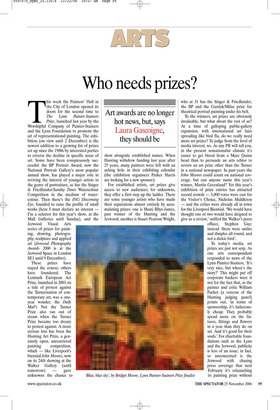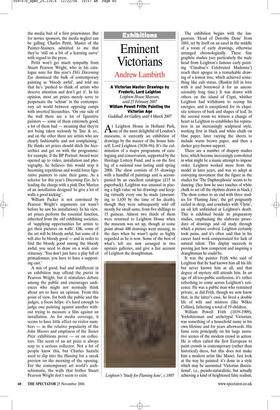Who needs prizes?
This week the Painters’ Hall in the City of London opened its doors for the second time to The Lynn Painter-Stainers Prize, launched last year by the Worshipful Company of Painter-Stainers and the Lynn Foundation to promote the art of representational painting. The exhibition (on view until 2 December) is the newest addition to a growing list of prizes set up since the 1980s by interested parties to reverse the decline in specific areas of art. Some have been conspicuously successful: the BP Portrait Award, now the National Portrait Gallery’s most popular annual show, has played a major role in reviving the interest of younger artists in the genre of portraiture, as has the Singer & Friedlander/Sunday Times Watercolour Competition in the medium of watercolour. Then there’s the ING Discerning Eye, founded to raise the profile of small works (here I must declare an interest — I’m a selector for this year’s show, at the Mall Galleries until Sunday), and the Jerwood Visual Arts series of prizes for painting, drawing, photography, sculpture and applied art (Jerwood Photography Awards 2006 is at the Jerwood Space in London SE1 until 9 December).
These prizes have stayed the course; others have foundered. The Lexmark European Art Prize, launched in 2003 on a tide of protest against the Turnerisation of contemporary art, was a oneyear wonder; the Daily Mail’s Not the Turner Prize also ran out of steam when the Turner Prize became too dreary to protest against. A more serious loss has been the Hunting Art Prize, a genuinely open, unrestricted painting competition, which — like Liverpool’s biennial John Moores, now on its 24th showing at the Walker Gallery (until tomorrow) — gave unknowns the chance to show alongside established names. When Hunting withdrew funding last year after 25 years, many painters were left with an aching hole in their exhibiting calendar (the exhibition organisers Parker Harris are looking for a new sponsor).
For established artists, art prizes give access to new audiences; for unknowns, they offer a first step up the ladder. There are some younger artists who have made their reputations almost entirely by accumulating prizes: one is Shani Rhys-James, past winner of the Hunting and the Jerwood; another is Stuart Pearson Wright, who at 31 has the Singer & Friedlander, the BP and the Garrick/Milne prize for theatrical portrait painting under his belt.
To the winners, art prizes are obviously invaluable, but what about the rest of us? At a time of galloping public-gallery expansion, with international art fairs spreading like bird flu, do we really need more art prizes? To judge from the level of media interest, no. As any PR will tell you, in the present sensationalist climate it’s easier to get blood from a Marc Quinn head than to persuade an arts editor to review an art prize other than the Turner in a national newspaper. In past years the John Moores could count on national coverage, but can anyone name this year’s winner, Martin Greenland? Yet this year’s exhibition of prize entries has attracted record crowds — 5,000 votes were cast for the Visitor’s Choice, Nicholas Middleton — and the critics were already all in town for the Liverpool Biennial. ‘We would have thought one or two would have deigned to give us a review,’ sniffed the Walker’s press officer, Stephen Guy; instead ‘there were smiles and dimples all round, and not a dickie bird’.
To today’s media, art prizes are just not sexy. As one arts correspondent responded to news of the Lynn Painter-Stainers, ‘It’s very nice, but where’s the story?’ This might put off corporate backers were it not for the fact that, as the painter and critic William Packer (a veteran of the Hunting judging panel) points out, ‘in terms of sponsorship, it’s ludicrously cheap. They probably spend more on the fixtures, fittings and flowers in a year than they do on art. And it’s good for their souls.’ For charitable foundations such as the Lynn and the Jerwood, publicity is less of an issue; in fact, so unconcerned is the Jerwood with chasing press coverage that next February it’s relaunching its painting prize without the media bait of a first prizewinner. But for novice sponsors, the media neglect can be galling: Charles Pettit, Master of the Painter-Stainers, admitted to me that they’re ‘still on a bit of a learning curve’ with regard to the press.
Pettit won’t get much sympathy from Stuart Pearson Wright, who in his catalogue note for this year’s ING Discerning Eye dismissed the bulk of contemporary painting as ‘bloody awful’, and told me that he’s ‘pushed to think of artists who deserve attention and don’t get it’. In his opinion, most art prizes merely serve to perpetuate the ‘schism’ in the contemporary art world between opposing camps with inverted hierarchies. ‘On one side of the wall there are a lot of figurative painters — some of them extremely good, a lot of them bad — moaning that they’re not being taken seriously by Tate & co., and on the other there are artists who are clearly fashionable and not complaining.’ He thinks art prizes should ditch the hierarchies and get on with the programme: for example, if the BP Portrait Award were opened up to video, installation and photography, he believes this would stop it becoming repetitious and would force figurative painters to raise their game. As a selector for this year’s Discerning Eye, he’s leading the charge with a pink Doc Marten of an installation designed ‘to give a lot of walls a good kicking’.
William Packer is not convinced by Pearson Wright’s arguments (or wasn’t before he saw his installation). In his view, art prizes perform the essential function, inherited from the old exhibiting societies, of ‘supplying opportunities for artists to get their pictures on walls’. OK, some of the art will be bloody awful, but some of it will also be bloody good — and in order to find the bloody good among the bloody awful, you need to draw on a wide constituency. ‘You don’t just have a play full of primadonnas; you have to have a supporting cast.’ A mix of good, bad and indifferent in an exhibition may offend the purist in Pearson Wright, but it stimulates debate among the public and encourages audiences who might not normally think about art to have an opinion. From this point of view, for both the public and the judges, a focus helps: it’s hard enough to judge one painting against another without trying to measure a film against an installation. As for media coverage, it seems to have little effect on visitor numbers — as the relative popularity of the John Moores and emptiness of the Turner Prize exhibitions prove — or on collectors. The scent of an art prize is always sexy to a serious collector. Not a lot of people know this, but Charles Saatchi used to slip into the Hunting for a sneak preview on the morning of the opening. For the contemporary art world’s archschismatic, the walls that bother Stuart Pearson Wright don’t seem to exist.



























































































 Previous page
Previous page